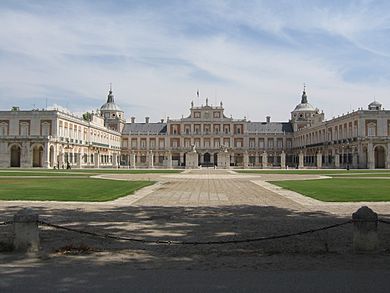Concierto de Aranjuez facts for kids

The Concierto de Aranjuez ([konˈθjeɾ.to ðe a.ɾaŋˈxweθ], "Aranjuez Concerto") is a concerto for classical guitar by the Spanish composer Joaquín Rodrigo. Written in 1939, it is by far Rodrigo's best-known work, and its success established his reputation as one of the most significant Spanish composers of the 20th century.
Contents
Inspiration and history
The Concierto de Aranjuez was inspired by the gardens at the Royal Palace of Aranjuez, the spring resort palace and gardens built by Philip II in the last half of the 16th century and rebuilt in the middle of the 18th century by Ferdinand VI. The work attempts to transport the listener to another place and time through the evocation of the sounds of nature.
According to the composer, the first movement is "animated by a rhythmic spirit and vigour without either of the two themes... interrupting its relentless pace"; the second movement "represents a dialogue between classical guitar and solo instruments (cor anglais, bassoon, oboe, horn etc.)"; and the last movement "recalls a courtly dance in which the combination of double and triple time maintains a taut tempo right to the closing bar." He described the concerto itself as capturing "the fragrance of magnolias, the singing of birds, and the gushing of fountains" in the gardens of Aranjuez.
Rodrigo and his wife Victoria stayed silent for many years about the inspiration for the second movement, and thus the popular belief grew that it was inspired by the bombing of Guernica in 1937. In her autobiography, Victoria eventually declared that it was both an evocation of the happy days of their honeymoon and a response to Rodrigo's devastation at the miscarriage of their first pregnancy. It was composed in 1939 in Paris.
Rodrigo dedicated the Concierto de Aranjuez to Regino Sainz de la Maza.
Rodrigo, nearly blind since age three, was a pianist. He did not play the guitar, yet he still managed to capture and project the role of the guitar in Spanish music.
Political context
In 1939, the Spanish Civil War had just ended, beginning (or continuing, depending on the part of Spain) the Spanish State of dictator Francisco Franco. A work premiered in Spain in this highly charged environment had to celebrate, or pretend to celebrate, or permit the interpretation that it was celebrating, the current political situation. The celebration of a palace and gardens of a sixteenth-century Habsburg king offered no ideological threat to the Francoist State, and was in harmony with its emerging policy of celebrating Spanish history, conservatively interpreted.
Composition
Composed in early 1939, in Paris, amid the tensions of the impending war, it was the first work Rodrigo wrote for guitar and orchestra. The instrumentation is unusual: rarely does the guitar face the forces of a full orchestra. Thus, the guitar is never overwhelmed.
Premiere
The premiere of the Concierto de Aranjuez was held on 9 November 1940 at the Palau de la Música Catalana, in Barcelona. It was performed by guitarist Regino Sainz de la Maza with the Orquesta Filarmónica de Barcelona conducted by César Mendoza Lasalle.
On 11 December 1940, the concerto received its first performance in Madrid, at the Teatro Español de Madrid conducted by Jesús Arámbarri, with the same soloist. The United States premiere was given by Rey de la Torre on 19 November 1959, with the Cleveland Orchestra conducted by Robert Shaw.
Structure
This concerto is in three movements, Allegro con spirito, Adagio and Allegro gentile. The first and last movements are in D major, while the famous middle movement is in B minor. Along with the solo guitar, it is scored for an orchestra consisting of two flutes (one doubling on piccolo), two oboes (one doubling on cor anglais), two clarinets in B♭, two bassoons, two horns in F, two trumpets in C, and strings.
First movement
The first movement's 40-measure introduction begins with the solo guitar strumming a three-measure theme in 6/8. The theme is made of tonic, supertonic, and dominant chords and features a flamenco-like hemiola rhythm. As it repeats several times, the tonic chord's uppermost note gets higher, starting with the third, then using the fifth, the tonic, and the fifth again.
- Introduction (guitar)
- 1st theme (1st oboe and 1st violins)
- 2nd theme (guitar, D major to E♭ major)
Second movement
The second movement in B minor, the best-known of the three, is marked by its slow pace and quiet melody, introduced by the cor anglais, with a soft accompaniment by the guitar and strings. A feeling of quiet regret permeates the piece. Ornamentation is added gradually to the melody in the beginning. An off-tonic trill in the guitar creates the first seeds of tension in the piece; they grow and take hold, but relax back to the melody periodically. Eventually, a climactic build-up starts. This breaks back into the main melody, molto appassionato, voiced by the strings with accompaniment from the woodwinds. The piece finally resolves to a calm arpeggio from the guitar, though it is the strings in the background rather than the guitar's final note that resolve the piece.
- Introduction (guitar, B minor)
- Theme (English horn)
Third movement
The third movement is in mixed metre, alternating between 2/4 and 3/4. At the beginning of the movement, four-measure phrases containing 9 beats in total are formed from one 3/4 measure followed by three 2/4 measures. As the movement progresses, the metre becomes more irregular. It begins with the guitar starting the theme in the "wrong" key of B major, but the orchestra restates it in the home key of D major.
- Theme (guitar, B major)
Rodrigo's title of nobility
On 30 December 1991, Rodrigo was raised to the Spanish nobility by King Juan Carlos I with the title of Marqués de los Jardines de Aranjuez (English: Marquess of the Gardens of Aranjuez).
See also
 In Spanish: Concierto de Aranjuez para niños
In Spanish: Concierto de Aranjuez para niños


